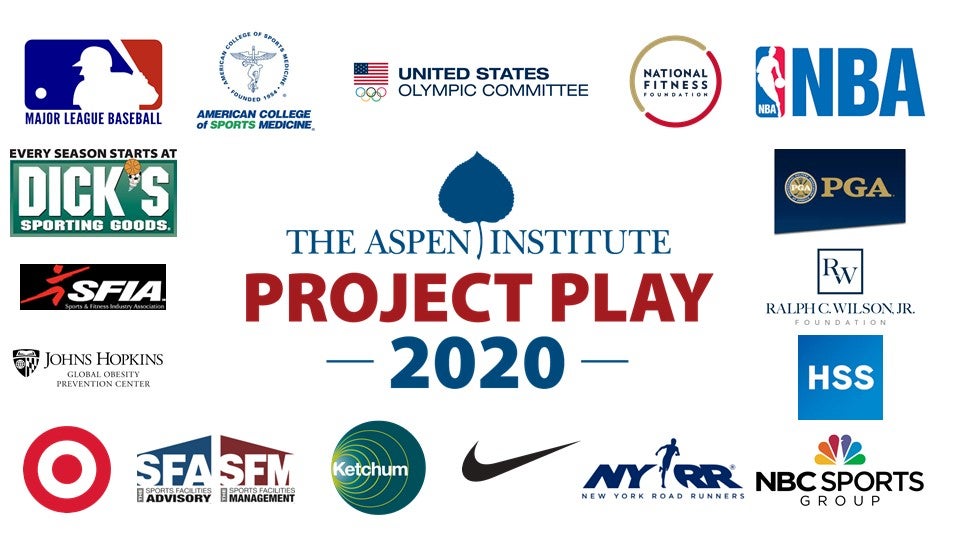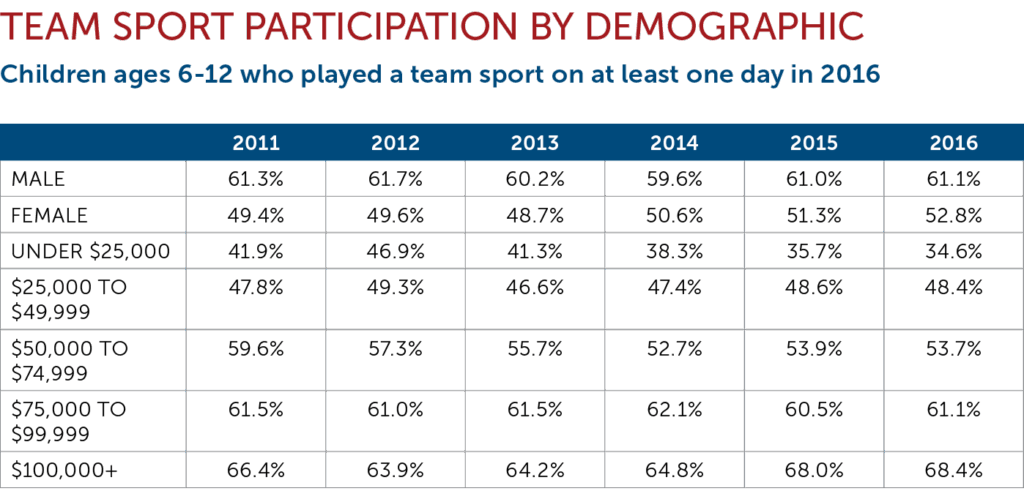The Aspen Institute’s Project Play Summit was held Sept. 6. Portions of the Summit were streamed live, including Major League Baseball Commissioner Rob Manfred’s featured conversation. Read the Summit recap here.
The Aspen Institute is collaborating on a multi-year effort by more than a dozen leading sport, health, media and other organizations to grow national sport participation rates and related metrics among youth.
The need is clear for Project Play 2020. The new initiative represents the first time that industry groups and non-profits have come together to develop shared goals around making sport accessible to all children, regardless of zip code or ability.
“No one organization alone can build healthy kids and communities through sports,” said Tom Farrey, executive director of the Aspen Institute’s Sports & Society Program. “It will take like-minded groups, even competitors, collaborating to get kids off the couch without running them into the ground.”
The founding members of Project Play 2020 are Nike, NBC Sports Group, Target, National Basketball Association, Major League Baseball, Dick’s Sporting Goods, U.S. Olympic Committee, Hospital for Special Surgery, PGA of America, Ralph C. Wilson, Jr. Foundation, New York Road Runners, National Fitness Foundation, American College of Sports Medicine, Ketchum Sports & Entertainment, Sports Facilities Advisory, Sports & Fitness Industry Association (SFIA), and the Global Obesity Prevention Center (GOPC) at Johns Hopkins University. The Centers for Disease Control and Prevention is advising the group.
The number of kids playing sports keeps decreasing. According to new data released by the Aspen Institute’s Sports & Society Program, only 36.9 percent of children ages 6-12 played team sports on a regular basis in 2016 – down from 38.6 in 2015 and 44.5 in 2008.
The concerning trends, produced annually by SFIA, rarely change each year:
- Children from homes in the lowest income bracket are far more likely to be physically inactive than kids from wealthier households
- For most sports, participation rates on a regular basis keep declining, with only gymnastics, lacrosse and ice hockey experiencing increases between 2008-16
- The average child plays fewer than two sports – a statistic now on a regular down cycle due to sport specialization, even though evidence shows playing only one sport can be harmful to the body and stunt athletic development
- Less than one-third of youth coaches are trained in competencies such as safety and sport instruction
The founding Project Play 2020 members will develop mutually reinforcing actions over the next three years consistent with the framework of Project Play’s seminal report, Sport for All, Play for Life: A Playbook to Get Every Kid in the Game. Other organizations will be invited to join a broader coalition that offers benefits for aligning efforts.
Two of the report’s eight strategies — Encourage Sport Sampling and Train All Coaches — will be an initial focus of Project Play 2020. Through work groups, members will develop opportunities to introduce kids to more sports, and to grow the quality and quantity of coaches.
What follows are charts that speak to the challenges that Project Play 2020 will collectively try to address.
All data below provided by the Sports & Fitness Industry Association and Sports Marketing Surveys at the request of the Aspen Institute.
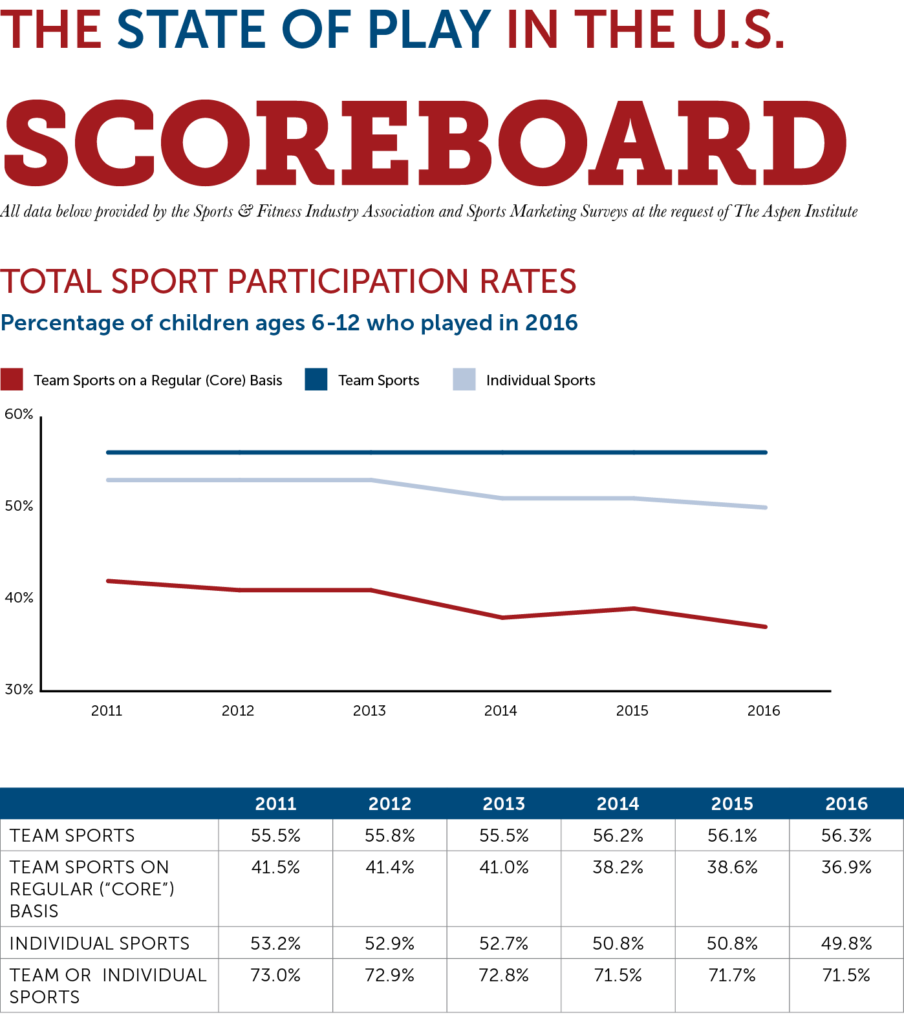
Team sports include: baseball, basketball, cheerleading, field hockey, football (flag, touch, tackle), gymnastics, ice hockey, lacrosse, paintball, roller hockey, rugby, soccer (indoor, outdoor), softball (slow-pitch, fast-pitch), swimming on a team, track and field, ultimate frisbee, volleyball (court, grass, sand), and wrestling. Individual sports include: tennis, golf, martial arts, roller skating, skateboarding, running, and bicycling (BMX, mountain, road).
A participant is anyone who played a sport at least one day a year, in any form, organized or unstructured. A “core” participant is anyone who participated on a regular basis, a number of times per year that varies by sport, as defined by SFIA, and usually includes a level of organized play; whether playing on one team or multiple teams, they are only counted once.
According to SFIA, the percentage of kids 6-12 playing team sports in 2016 slightly increased. However, the rates keep dropping for kids who play team sports on a regular basis and those who play individual sports.
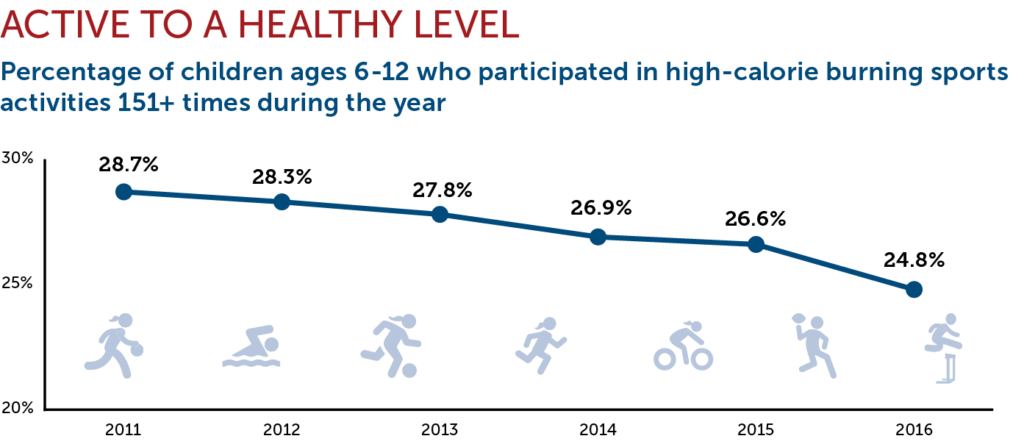
Sports considered by SFIA to be high-calorie include: bicycling (BMX, mountain, road), running/jogging, basketball, field hockey, football (tackle, touch), ice hockey, roller hockey, lacrosse, rugby, soccer (indoor, outdoor), swimming (on a team or for fitness), track and field, badminton, racquetball, squash, tennis, cross-country skiing, martial arts, wrestling, stand-up paddling, climbing (sport, traditional), trail running, triathlon, snowshoeing, boxing, dance, step, and other choreographed exercise to music. The list also includes several activities more associated with teens and adults, including high impact/intensity training, cardio kickboxing, stationary cycling, rowing machine, stair-climbing machine, treadmill, aquatic exercise, bodyweight exercise, cross-training style workouts, pilates training, adventure racing, cardio tennis, pickleball, MMA, and other combat training.
From 2011-15, the percentage of kids 6-12 who were considered active to a healthy level (151+ high-calorie burning sports activities during the year) slowly decreased. The decline was much steeper in 2016, dropping by nearly two percentage points.
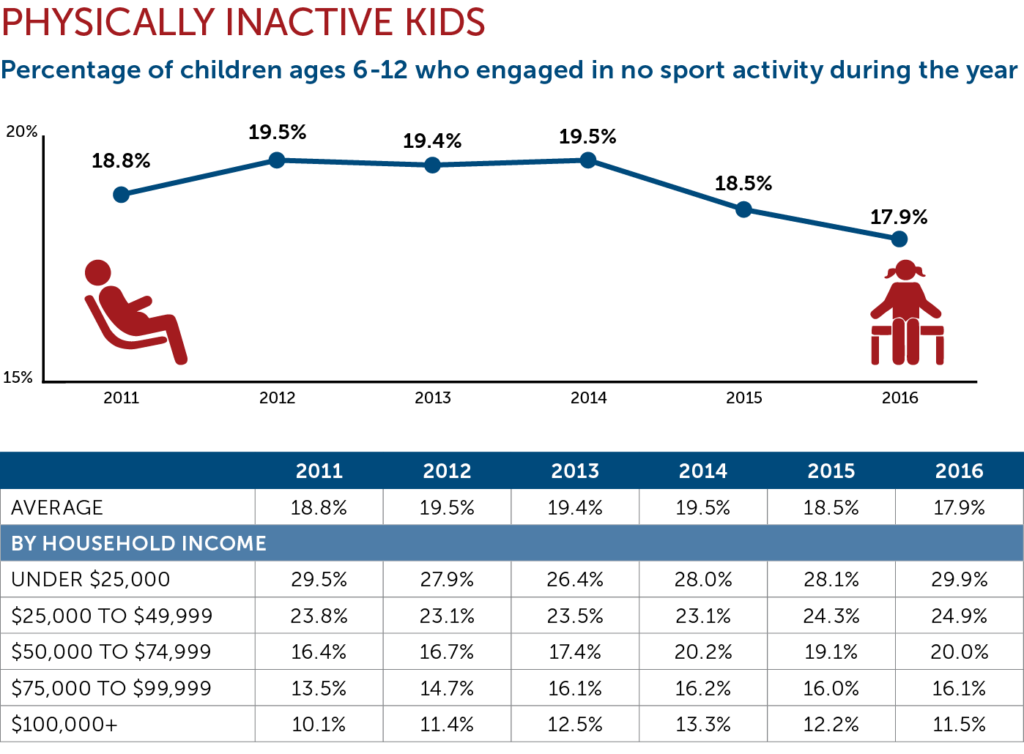
High-income households ($100k+) now take up a larger share of households with children than in 2011, according to Sports Marketing Surveys. The volume of children from the population segment—which is nearly three times less likely to be physically inactive as kids from low-income homes—has pushed down the overall percentage of children who are inactive, even as the rate grew within each income category.
Money continues to be a major driver of sports participation. In 2016, 29.9 percent of kids from homes in the lowest income bracket ($25,000 or less) were physically inactive. Only 11.5 percent of children in the wealthiest households ($100,000 or more) were considered physically inactive.
Household income is also a major factor for kids 6-12 who played a team sport on at least one day. In 2013, the gap between kids in homes with incomes under $25,000 and those with $100,000+ households was about 23 percentage points. In 2016, the gap had increased to 32 percent percentage points. Some positive news: The overall percentage of females playing a team sport at least one day continues to improve, and the overall percentage of boys has held steady.
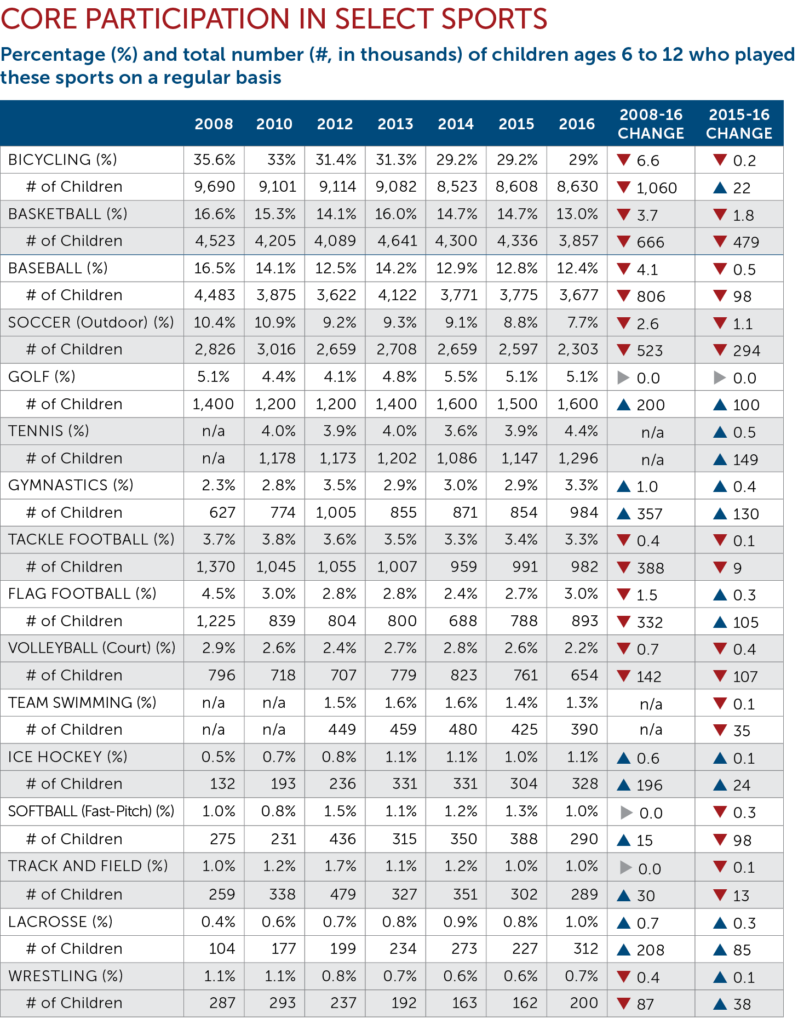
Source: Data for tennis and golf provided by the Tennis Industry Association and the National Golf Foundation, respectively. All other data courtesy of Sports & Fitness Industry Association/Sports Marketing Surveys.
While most youth sports rates are generally declining, some specific sports are doing better than others. SFIA tracks core participation, meaning kids who played certain sports on a regular basis. In 2016, tennis, gymnastics, flag football, hockey, lacrosse and wrestling had slight increases. Basketball, baseball and soccer — three of the most popular — declined again in 2016.
Not enough coaches are being trained in general safety and injury prevention, sport instruction, concussion management, motivational techniques, CPR/First Aid, and physical conditioning. Also, the gap between male and female coaches continues to be large. The youth sports industry is missing opportunities to get more women involved.
Solutions
It’s in this landscape that Project Play 2020 will try to collectively improve youth sports opportunities. Lifting the number of kids who get and stay active will save tens of billions of dollars in direct medical costs and economic productivity losses alone, according to an analysis by the Global Obesity Prevention Center at Johns Hopkins.
Health and Economic Benefits of Progress
At the request of the Aspen Institute, the Global Obesity Prevention Center at Johns Hopkins University simulated the physical activity behavior of youth during the years of 2010 to 2020. Included were scenarios where 50 percent, 75 percent, and 100 percent of the youth meet the standard of “Active to a Healthy Level” (25 minutes of physical activity, three times a week) and 100 percent meet the Centers for Disease Control and Prevention (CDC) recommendation (one hour of physical activity, daily), compared to current physical activity trends, as reported by the Sports & Fitness Industry Association.
Fewer Overweight and Obese Youths: Number of additional youths dropping below 85 percent BMI percentile.
Direct Medical Costs Saved: By reducing youth’s BMI, they will be less likely to develop obesity-related health conditions in life (e.g., stroke, cancer, heart disease, and diabetes). Avoiding such conditions will save medical costs such as hospitalizations, medications, and doctors’ visits.
Productivity Losses Saved: Avoiding obesity-related conditions will make people more productive (e.g., fewer sick days and longer lives), which will provide savings for businesses and society.
Years of Life Saved: Avoiding obesity-related health conditions will also lengthen people’s lives.
Stay connected with Project Play 2020 for updates:
Website: www.ProjectPlay.us
Twitter: @AspenInstSports
Facebook: facebook.com/aspeninstsports
Q&A on Project Play 2020
What are the areas that the group is focused on?
Project Play 2020 will focus on developing actions that address the following KPIs – we’ll call them “Key Play Indicators” – for youth through age 12. These KPIs are measured annually on a national level by the Sports Fitness Industry Association through a household survey conducted by Sports Marketing Surveys:
- Sport participation among youth
- Youth coaches trained in key competencies
- Average number of team sports played
- Inactive children – i.e. lowering the number of kids engaged in no activity
Why did we choose the Year One priorities of coaching and sport sampling?
Train All Coaches and Encourage Sport Sampling are two of the eight plays, or strategies, recognized by the Aspen Institute in the Sport for All, Play for Life: A Playbook to Get Every Kid in the Game as key in stakeholders getting and keeping kids active through sports. The group will use the report as a filter to identify annual priorities, and was determined that initially it could make progress in these two areas.
How will this group go about its development of opportunities?
The founding members of Project Play 2020 comprise the initiative’s Project Play 2020 Advisory Group, who collectively guide the overall development of the initiative, help determine annual priorities and agree to make a commitment to action consistent with one or more of the KPIs. With the annual priorities now set, Working Groups have been created to develop and execute the strategy on behalf of each one. Members self-select one of the Working Groups to join with the remit to develop partnerships and utilize resources and assets to support the annual priorities.
What is Aspen’s role?
The Aspen Institute Sports & Society Program is the backbone organization in charge of applying the collective impact methodology to support the Advisory Group and help drive Project Play 2020’s goals. The Institute has a multi-faceted role that includes: facilitating the development of a shared agenda, analyzing data to find opportunities and track progress, fostering communication across all groups, and providing ideas to the Advisory Group that support their efforts to create mutually reinforcing actions. Where appropriate, Aspen will also assist or take the lead in the development of resources and tools.
What type of programs or initiatives could emerge from this group’s work?
- Grant-making or policies that address the KPIs or annual priorities
- Deployment of an organization’s resources to create or enhance a program
- Introduction of breakthrough solutions (e.g., technology, media)
- Announcement of a new or enhanced partnership
- Leadership in rallying other entities within each organization’s sector
- Creation of a PSA or communication campaign
- Other interventions or programs
- Pilot projects in regions and cities
How will this group measure success?
We will monitor the KPIs on a timely basis while also setting specific goals within each of the annual priorities, such as the development of resources to grow the quality and quantity of youth coaches. We will also endeavor to achieve more immediate wins that support the annual priorities and other “plays,” such as the Parent Checklists supported by Target and distributed at the 2017 Project Play Summit.
Can other organizations join Project Play 2020?
Yes, a select number of motivated organizations will be invited to join the Advisory Group as the initiative continues to evolve. We will also look to invite other organizations to join Project Play 2020’s broader coalition if their efforts align with the goals of Project Play 2020, with its clear, 20-20 vision of what good looks like in youth sports and belief that achieving this vision depends on collection action.
